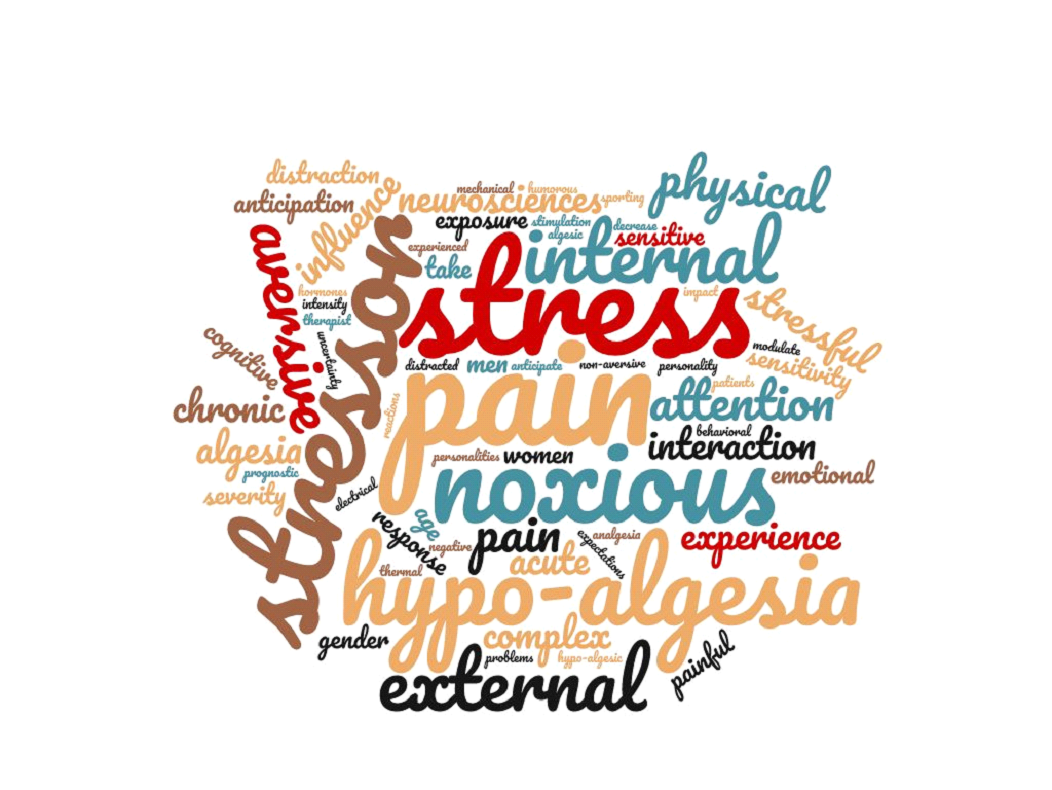The interaction between stress and pain perception is complex. Stress has undoubtedly impact on pain perception. This can be either an increase in pain perception (hyperalgesia) or a decrease in pain perception (hypo-algesia). For the occurrence of this stress-induced algesia 2 stimuli are necessary, namely a stressful or aversive stimulus and a painful or noxious stimulus. Whether hyper- or hypo-algesia will occur depends on several external and internal factors. External factors include type of stressor, duration of stress, severity of stress and type of noxious stimulus. Internal factors include anticipation to pain, distraction from pain, gender, age, experience with pain or stressful stimuli and personality differences.

If we take a closer look at the external factors, the type of stressor can be described as physical, emotional or cognitive stress. Examples of these types are sporting (physical), relationship problems or deadlines at work (emotional) and negative expectations about performance (cognitive). The duration of stress has also influence on the direction of algesia. In general, chronic stress results in hyperalgesia and this hyperalgesia will last longer compared to acute stress what results in hypo-algesia. Furthermore, the severity of the stressor may modulate pain sensitivity, where severe stressors evoke hypo-algesia and less severe stressors evoke hyperalgesia. A possible explanation for this might be that attention is taken away from the pain if the aversive stimulus is severe enough or attention is increased with less severe stimuli. Generally, during hypo-algesia, attention is shifted towards the stressor, while in hyperalgesia attention is directed towards the pain. This is not always the case, as a stressor irrelevant to pain can both enhance and suppress pain depending on the intensity of the stressor. In addition, repeated exposure to mild stressors might create uncertainty about future threats and herewith changing the direction of algesia. Finally, the type of a noxious stimulus can influence the algesic effects. Mechanical, thermal or electrical stimulation can be experienced and one can react differently to these different noxious stimuli while the stressor is the same.

When focussing on the internal factors, again various reactions are possible. When one can anticipate to or is distracted from a noxious stimulus a hypo-algesic response will occur. Distraction can also take place in non-aversive circumstances. Regarding gender, men tend to have hypo-algesia in a larger extent than women. A possible explanation for this might be the difference in hormone levels in men and women. Moreover, for age and experience with pain or stress, no clear pattern of hyper- or hypo-algesia is found. The direction depends on the stressful and noxious stimuli. For example, the repeated exposure to stressors could lead to hyperalgesia. Finally, as a consequence of different personalities, one may react humorous or more serious to a stress stimulus and this may change the direction of pain perception.
As you can see, many factors can influence the interaction between stress and pain perception. The interaction between all these various factors makes it even more complex to understand the pain perception as a consequence of stress. Therefore there is no clear response to painful stimuli during a period of stress. Now think about yourself and how you react to pain in different circumstances and with different levels of stress and try to answer the question below.
What is your experience regarding stress and pain perception? In general, as a result of stress I am …
1 … more sensitive to pain;
2 … less sensitive to pain;
3 Other and specify what or when;
You can answer by clicking on this link: https://linkto.run/p/052NBDQ4
The results can be followed by clicking the following link: https://linkto.run/r/052NBDQ4
Michel GCAM Mertens
Member of the International Pain in Motion Research group and the MOVANT research group
Physical therapist currently working at the University of Antwerp as lecturer and PhD student in the domain of prognostic factors in patients with frozen shoulder
2019 Pain in Motion
References and further reading:
Olango WM, Finn DP. Neurobiology of stress-induced hyperalgesia. Current topics in behavioral neurosciences 2014; 20: 251-80. https://www.ncbi.nlm.nih.gov/pubmed/24850075
Butler RK, Finn DP. Stress-induced analgesia. Progress in neurobiology 2009; 88(3): 184-202. https://www.ncbi.nlm.nih.gov/pubmed/19393288